One of the things about chooks in a chook tractor, they have access available 24/7 to the major requirement of a dust bath: dust! It has only just recently penetrated my consciousness that the chooks in the retirement village do not!
Chooks scratch up the soil and then roll around in the resulting dirt and dust, they do that in the chook tractor. They then stand up, fluff out their feathers and shake themselves, shaking off the fine dust and then they preen themselves – This is dust bathing and it seems it is a natural chook behaviour, and it makes them happy, but I wanted to know more.

Experimental dust bath, filled with the finished product
I thought that I would do a bit of digging (ha ha!) and see what I could find about the ‘why’, ‘what’ and ‘where’ of dust baths for our chooky friends.
Dust baths, why bother?
It seems that the ability to dust bath (bathe?) can have a number of positive benefits on the life of a chook:
Pest control - There are a number of possible pests that could annoy chooks, including fleas, mites, lice, and ticks. The likelihood of some of these pests being a problem is increased the more they can interact with wild birds. Our chook retirement village is pretty much proof against wild bird interaction, but I guess anything is possible.
Feather Health – as chooks roll around in the soil, fine particles of sand and earth are able to work their way between their feathers, in effect cleaning the feathers and keeping them functional. They then retrieve oil from a gland at the base of their tail (called the uropygial gland) with their beak and apply it to their feathers while preening.
Skin Care – A dust bath allows the chook to work the particles of dirt into their feathers and skin they then shake their bodies in a way like a dog shaking water out of its coat, removing excess oil, dirt and dead skin cells. I have read that dust bathing can also remove excess sweat, but as birds do not have sweat glands, this seems unlikely.
Stress relief – dust baths make for not only healthy chooks but happy chooks, they get to carry out instinctive behaviour.
Heat relief - Dust bathing helps chooks cool down by absorbing excess oil and moisture from their feathers, which can trap heat. It also allows them to dig into the cooler soil underneath, providing a direct cooling effect.
Community building – the chooks who dust bath together……. dust bath together! Evidently dust bathing together helps chooks get on with each other. (who knew?)
Making the Dust Bath
One of the problems with the retirement village is that it has a floor of concrete tiles, the council requires an impervious flooring material, so that providing some soil access within the village floor was not possible. What I did have was an old, and fairly large, disused cat litter tray that had been sitting in the shed for some years. It is 490mm x 390mm x 140mm and so I figured it was a good place to start.
I next had to work out what the ‘dust’ I was going to supply for the dust bath would be composed of, there are a number of components that can be included –
- Soil – obviously, this is going to be the base and major component of any chook dust bath, hopefully it is friable, that is to say loose, porous and easily crumbled but if not, there are other dust bath constituents that can help with that. In any case, wherever you get it from, the soil you use should be pesticide and fertiliser free.
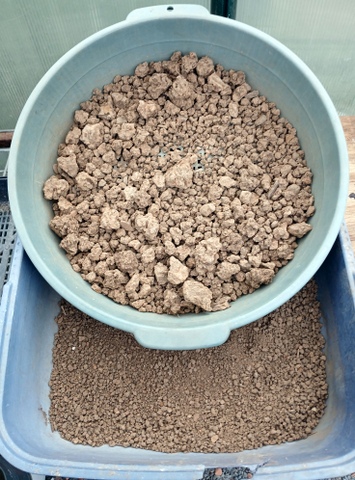
Soil before and after sieving
- Coarse Sand – this can help with the friability of the soil. The sand should be fine enough for fluff but coarse enough not to be inhaled by the chooks.
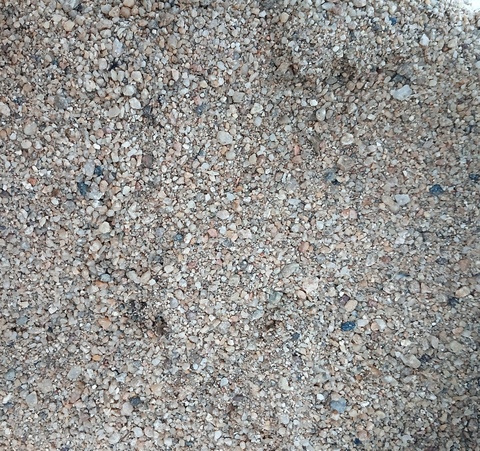
- Cocopeat – This makes the dust bath lighter and airier for the chooks and can absorb moisture if required.

- Wood ash – is a pest repellent. As with the soil, it is important that the wood ash does not contain any nasties, so should not be used if any of the ash could come from treated timber, or other irritants like nails, screws or other hardware. It will also raise the pH of the soil mix, making it more alkaline.
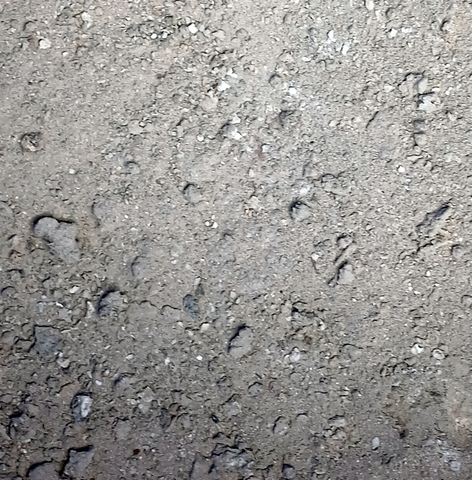
- Diatomaceous earth – this is another material that can help fight chook pests.

- Lime and sulphur – these can also act as a pest deterrent, but lime will raise the pH of the mix the same way that wood ash will and sulphur will drop the pH of the mix down.
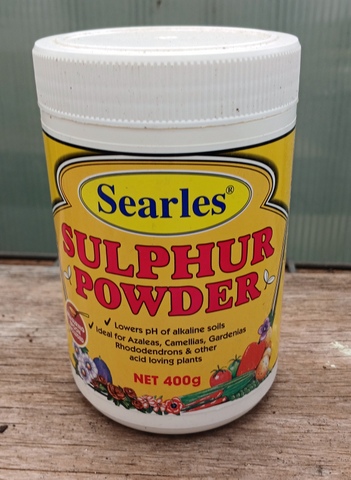

pH or Acidity/alkalinity of the mix
Since the main part of the dust bath will be composed of soil, it is a good idea to do a check on the pH of the soil you are going to use with a soil pH test kit to see if it is acid, neutral or alkaline. The best pH for the dust bath is around 6.5 to 7.5, in other words neutral to slightly acid or slightly alkaline. If the soil is outside this range a small amount of wood ash or lime can be added and mixed through to make it more alkaline (higher pH) or some powdered sulphur added to make it more acid (lower pH).

Original soil pH, around the 6.5 mark.

A bit much wood ash pushed the pH too high
How I made My Mix
I started out with soil from the front yard that I had dug up to allow me to check how well the soil drained when putting in the Rain Gardens, the leftover soil was contained in a couple of buckets. I put it through a soil sieve to remove any sticks, rocks and other material as well as breaking the soil up into a smaller particle size. Smaller particle size means it dries out faster and the chooks would have no trouble in tossing around. I then left in in an open container in the greenhouse so that it would dry out a bit, which would stop it from clumping together when the chooks walked on it.
To also keep the soil friable and well aerated I added some cocopeat and coarse sand and mixed it through the soil base. I then wanted to add in some anti-pest stuff, so I added in some wood ash, but this turned out to be too much wood ash because it drove the pH of the mix up too high. So I also added in some sulphur to act as a pest repellent but also bring down the pH of the final mix.
In the end, the mix I am currently using is as follows, in parts by volume. To measure things out I used a 600ml cup shaped fast food container.
Sieved soil 10 parts
Cocopeat 5 parts
Coarse Sand 4 parts
Wood ash 1 part
Sulphur .66 part
The next mix will only contain ¼ the amount of wood ash or less, depending on how the pH goes..
How well did it work?
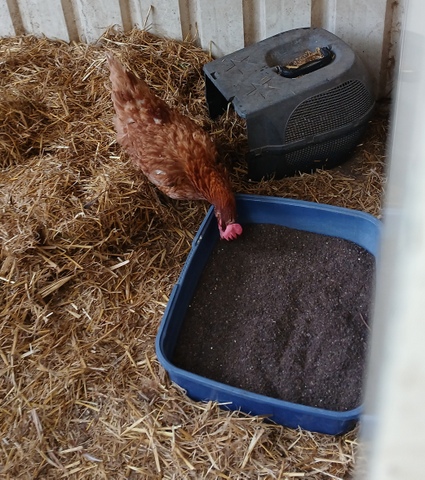
"Is this food?"
Initially they did not seem to be using it, or at least I didn’t see them but that seems to be rather that I was just not in the right place at the right time. After being a bit more vigilant, I have found that, yes, the chooks have been using it. As yet I still have been unable to get a pic of the chooks using it, and when I have tried to take a photo, the best I was able to get was a chook standing in the dust bath and giving me the outraged stare you would expect to get if you barged in on a woman in the shower (at least there was no screaming!).
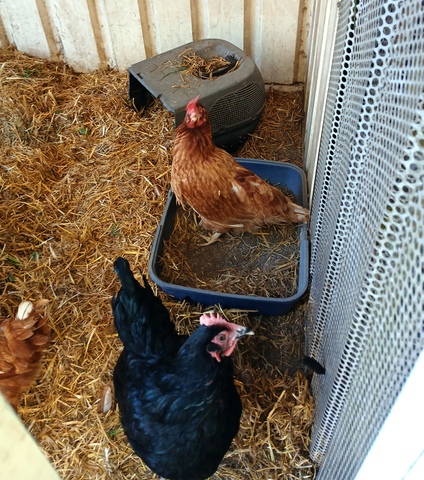
"HOW DARE YOU!!!!"
I was initially concerned about the lack of use and did a bit of checking, and there are a number of factors that can contribute to chooks not using the bath. If the dust bath is too wet (nah), dust bath components being unsuitable (nah), poor location (don’t think so!) or it being too small (hmmm!). I was designing a larger chook dust bath when I saw that they were actually using it. I have not totally discounted the idea, but I will see how things go!
Maintaining the Dust Bath
They will occasionally scratch some of the surrounding straw into it, and I have to drag it back out and evidently they can also drop feathers and chook poo in there so I need to keep an eye on it and keep the bath debris free as much as possible.
If the dust bath gets a bit smelly, you can toss in a bit of wood ash, lime or sulphur to freshen it up, just a small amount so as not to affect the pH too greatly.
They have been kicking some of the mix out onto the retirement village floor so every few days to a week or so I top it up with some of the original mix and give it a bit of a stir.
Last Thoughts
It took a while for the thought to sink in, but the chooks do seem happy with their new dust bath and I did see one of the chooks doing the ‘dog shake’ thing after a good dust bath, and a look of chooky contentment on her face. So if you haven’t already, give it a go, your chooks will love you for it!


